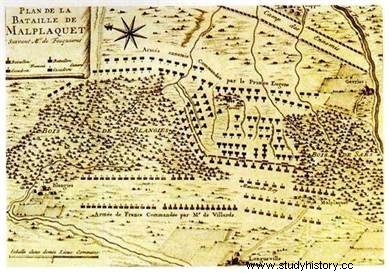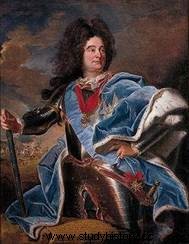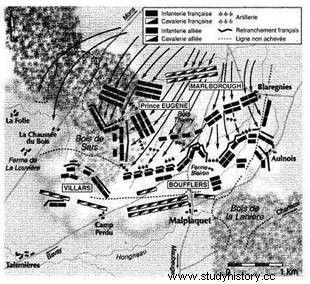 The Battle of Malplaquet , during the War of the Spanish Succession, took place on September 11, 1709 in the hamlet of Malplaquet, near Avesnes-sur-Helpe, in northern France. Appointed by Louis XIV at the head of the army of the Netherlands, Marshal de Villars faced the troops of the Grand Alliance formed by Austria, Great Britain and the United Provinces, and commanded by Prince Eugène de Savoy and the Duke of Marlborough. This indecisive battle was described as "bloodthirsty" by Marlborough. Although wounded during the Anglo-Imperial offensives and forced to abandon, Villars manages to bring his troops back in good order and inflict considerable losses on the attacker.
The Battle of Malplaquet , during the War of the Spanish Succession, took place on September 11, 1709 in the hamlet of Malplaquet, near Avesnes-sur-Helpe, in northern France. Appointed by Louis XIV at the head of the army of the Netherlands, Marshal de Villars faced the troops of the Grand Alliance formed by Austria, Great Britain and the United Provinces, and commanded by Prince Eugène de Savoy and the Duke of Marlborough. This indecisive battle was described as "bloodthirsty" by Marlborough. Although wounded during the Anglo-Imperial offensives and forced to abandon, Villars manages to bring his troops back in good order and inflict considerable losses on the attacker.
The start of the War of the Spanish Succession
Philippe d'Anjou, grandson of Louis XIV became king of Spain in November 1700, under the name of Philippe V. Everything could go for the best, but "the great The Hague Alliance” was formed in 1701 bringing together England, the United Provinces, the Holy Empire, Prussia and Savoy against France. The War of the Spanish Succession begins!
Successes and setbacks followed before the last defeat at Lille in December 1708, despite the defense of Marshal de Boufflers; France is in a very difficult financial situation, not to mention the harsh winter of 1708-1709 when the crops are all destroyed.
 The king should be reasonable and ask for peace, but cannot bring himself to do so. He therefore recomposed in June 1709, an army led by Marshal de Villars.
The king should be reasonable and ask for peace, but cannot bring himself to do so. He therefore recomposed in June 1709, an army led by Marshal de Villars.
In the forest of Malplaquet
On June 23, 1709, Marshal de Villars was on the Scheldt. The allies (enemies) take Tournai in July and move east to besiege Mons and Valenciennes. The French commanded by Marshals de Villars and de Boufflers at the head of 70 to 75,000 men and 80 guns find themselves facing the allies commanded by Prince Eugene in the service of the Empire and the Duke of Marlborough at the head of 100 to 110,000 men and 100 to 120 guns! The forces are unequal.
We are on a plateau between two valleys. On either side of the French positions are woods, one dark, the other almost clear. The Malplaquet gap is 1500 m wide, separated in two by the Bois Thierry.
Villars positions his army in a crescent with his back to the two woods, the center a little behind and shapes the terrain by raising land. The “History of Marlborough” mentions “the abatis were made; lands and fascines were raised; cannons were placed, so the soldiers of the allies did not fail to repeat that they had to fight a buried enemy, and that they were waging war against moles!
Faced with this position, Prince Eugene's generals hesitated to attack. But the prince pushes them "the enemy in front of us is weaker than the one who has been beaten so many times".
 September 11, 1709, at daybreak, the cavalry mounted their horses, the infantry took up arms . The sound of the cannon thunders from 7:30 a.m., the French army is attacked at 8 a.m., the King's regiment fleeing! Bad start! The left wing rushes into the woods pursued by the allies repatriated by Prince Eugene who runs everywhere and multiplies the attacks, despite his head injury. For his part, Villars weakened the center of several regiments to reconstitute the left wing (on the run) and managed to shoot the opposing infantry. Boufflers, on the right, intends to fight 30 Dutch battalions with his 8 battalions of Swiss and 3 regiments of dragoons…unfortunately who had been called up by Villars to support the left of the army! He can count on the Royal Infantry Regiment launching a bayonet attack to restore his position. But the center is bare!
September 11, 1709, at daybreak, the cavalry mounted their horses, the infantry took up arms . The sound of the cannon thunders from 7:30 a.m., the French army is attacked at 8 a.m., the King's regiment fleeing! Bad start! The left wing rushes into the woods pursued by the allies repatriated by Prince Eugene who runs everywhere and multiplies the attacks, despite his head injury. For his part, Villars weakened the center of several regiments to reconstitute the left wing (on the run) and managed to shoot the opposing infantry. Boufflers, on the right, intends to fight 30 Dutch battalions with his 8 battalions of Swiss and 3 regiments of dragoons…unfortunately who had been called up by Villars to support the left of the army! He can count on the Royal Infantry Regiment launching a bayonet attack to restore his position. But the center is bare!
At noon, Prince Eugene and the Duke of Marlborough hesitate to launch into the center of the French position, their armies although numerous are seriously tested with more than 21,000 men lost; Boufflers holds his right; Villars retreated to the left in the face of too many enemies, his horse was wounded, the Marshal was hit by a gunshot to the knee, managed to remove the bullet, fell unconscious, and was then transported out of the battlefield.
It was then that the rest of the allies limply launched into the center, to the surprise of the French aided by the Maison du Roi returning to the rescue. Boufflers is alone in having to lead the left wing, the right wing… as well as the defeated center and sometimes does not even know where the battalions are. At the end of the day, however, he is obliged to order the withdrawal!
Who won? Who lost ? It is customary that "he who leaves the battlefield is defeated". But what if the winner is so tired that he does not continue the fight?
Results of the Battle of Malplaquet
The great chiefs of command were affected:Prince Eugene in the head, Marshal de Villars in the leg...the Duke of Marlborough had disappeared and was considered dead...hence the famous song "Marlbrough s'en va-t-t -at war, mironton, mirontaine…” .
This great battle, the bloodiest in history, was won by the knockout of the allies. The French will still have lost 12,000 soldiers and the allies 20,000! The enemy could not invade France, as he wished! Avoiding collapse, France could thus continue the war advantageously.
To go further
- Battle of Malplaquet (1709), by André Corvisier. Economica, 2013.
- Perrin Dictionary of Wars and Battles in the History of France” - Jacques Garnier
